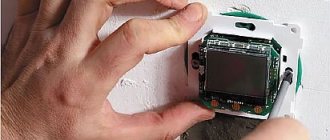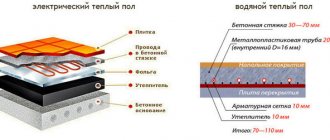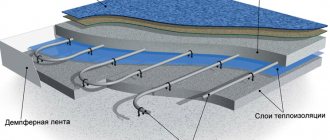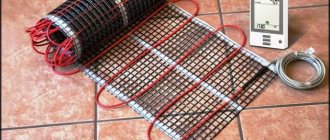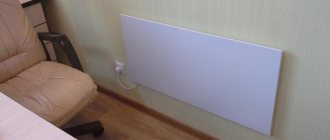An electric floor can have various modifications that differ from each other, for example, in design, methods of heat regulation and configuration. Therefore, the choice of system requires careful analysis. When choosing the equipment for a particular design, it is important to choose correctly whether it will be a single-core or double-core heated floor. First of all, it is necessary to understand the principle of operation of electric heating elements. The production of thermal energy is based on the properties of metals to generate heat when an electric current passes. Depending on the resistance value, the power can be adjusted. This parameter is affected by the material of the core and its diameter. The larger the cross-section, the more intense the heating will occur. But at the same time, electricity consumption increases significantly.
To make installation more convenient, and the system to be as durable as possible, already during the production process, the cable section at both ends is equipped with “cold ends” - power conductors made of copper.
Attention
You can only lengthen or shorten the cable itself, but not the copper ends.
If you are faced with choosing which underfloor heating element to prefer - single- or two-core, first you need to know the main characteristics of each of them, including the energy consumption of the heated floor for this option.
Energy consumption of thermal film
Before installing an infrared heating system, many often have a question: how much electricity does a warm electric floor consume?
For IR film, the power per 1 m² of floor surface is about 0.2 kW. Energy consumption will largely depend on the thickness of the screed, heat loss, and thermal insulation. To calculate the power consumed, use the formula: W=S*P*0.4,
where - S is the floor area of the room, P is the total power of all film elements, 0.4 is a coefficient that takes into account only the usable area for heating.
So, if the housing is not very well insulated, the film should be used with maximum power, for example, 0.2 kW per m². For a room of 20 m², the power consumption will be as follows:
W=20*0.2*0.4=1.6 kW/h.
Most often, such heating is used for about 7-10 hours a day, usually in the morning and evening. According to calculations, electricity consumption per day will be 15 kW, per month – 480 kW. And this is the power of only one room! It is enough to multiply the results obtained by your tariff to calculate the financial costs of such heating.
Power calculation
First, it is necessary to determine whether a single-core or two-core heated floor will serve as the main or auxiliary heating system, since this is what primarily determines their choice. We will show with an example how to calculate heat losses in a room and the power of the heating elements that best suits the conditions.
Let us assume that for an ordinary two-room apartment, the total heat consumption, taking into account the corresponding heat transfer resistance coefficients of surfaces, is 6 kW.
On a note
If the calculation is carried out for an auxiliary system, the power of the main one is also taken into account.
On average, for heating 10 square meters. m of living space should generate about 1 kW of heat. For example, when heating with the main heating is 90%, the missing 10% is compensated by the heated floor. That is, with our initial data, 90% is 5.4 kW and 0.6 kW is missing, of course, provided that the floors are heated throughout the entire area of the apartment.
This state of affairs is quite rare - most often heated floors are installed in specific rooms: in the kitchen, in the bathroom. To facilitate calculations, it is customary to use average power values for premises of this type:
- for kitchen and living space - 110-150 watts per square meter. m;
- for shower, bathroom - 140-150 watts per square meter. m
Another determining factor is temperature comfort. As a rule, more intense heating is provided by two-core models. The required thermal microclimate will be regulated depending on the time required to heat the floor. If there are no special temperature requirements, you can use a single-core model.
Which floor to choose: single-core or double-core?
One of the popular heating systems that heats the air in a room is underfloor heating. Depending on the type of heating elements, the following types of underfloor heating are distinguished:
- electric - liquid-electric, film and cable (single-core and two-core underfloor heating);
- water (hot water is used as a heat source).
Electric floor installation diagram.
Installation of such a heating structure can completely replace the centralized heating system and you will no longer need to purchase additional electric heating devices, which take up extra space in your apartment and inefficiently consume electricity. Electric cable flooring, depending on the heating cable used, is divided into single-core and two-core. Many people are wondering what to choose - a single-core or double-core cable for insulating a room. Below we will consider the main characteristics and differences of such cables.
Laying schemes for heated floors.
A single-core wire consists of one metal core covered with an insulating substance. The cable material is usually nichrome, brass, galvanized steel or carbon compounds. The cable has durable insulation that can withstand heat up to 100°C and can be made of silicone, polyethylene and Teflon. The insulating layer contains a copper or steel screen that protects the heating core from damage and serves as a grounding conductor.
The entire structure is connected to the network using 2 couplings and 2 wire ends that do not heat up. In this design, cold wires are connected to the 2 edges of the heating section. The advantage of such a system is the low cost of the starting material. Due to its design features, a single-core cable is more fragile and can break if installed incorrectly.
A two-core cable is slightly different from a single-core cable in its design. Such a cable has 2 wires insulated from each other (cold and heating) running in parallel under the outer sheath. These wires are attached to one side of the heating section.
There are no differences in quality and service life between the two heating elements being compared. However, a two-core floor has a cap at each end of the section that connects and reinforces them. The other 2 parts are similarly connected using a coupling and cold ends of the wire.
A two-core cable floor is easier to install, since it already has a ready-made end for connecting to the electrical network. And after installation, the end of the single-core cable must be returned to the connection point (looped).
The main criteria that influence the choice are: the type and size of the room in which such a structure will be installed and the thickness of the screed. Experts recommend using a single-core system in small and warm rooms, and a double-core floor for potentially cold, damp and spacious rooms. In apartments, cottages and private houses, a two-core heated floor is usually used to install heated floors. And in public, office and non-residential premises it would be more advisable to use a single-core cable, since almost any conductor with electric current generates electromagnetic radiation, which is unsafe for both people and animals. In a single-wire cable, current flows in one direction, creating harmful electromagnetic radiation.
The two-core heated floor does not emit harmful electromagnetic waves.
A two-core cable has 2 wires with mutually directed electromagnetic fields that neutralize each other. There are no differences in quality and service life between both systems.
It is also necessary to take into account that when using such a cable heating structure, the floor height will rise by 5-10 cm. The electric cable heating system is universal and is suitable for many types of coatings (linoleum, tiles, carpet, laminate, natural stone). It helps evenly and correctly distribute warm air throughout the room thanks to the regulator. Modern developments and technologies make it possible to shield heating cable cores to the maximum extent possible. Today, heated floors are an environmentally friendly, economical, practical and very convenient solution for insulating your home.
1poteply.ru
Deviations regarding single-core. Single-core and stranded wire, what is the difference
Quite often you can hear people trying to compare these two types of cable products and find out which wires are better, multi-core or single-core? Let us say right away that such a formulation of the question is generally incorrect and shows the incompetence of the questioner. After all, you can also ask: “Which is better, a shovel or a hammer?”, and the answer depends not on the objects, but on the type of activity that will be carried out with the help of a certain tool.
The choice of conductor type in a cable or wire equally depends on 1) location and 2) operating conditions. Therefore, instead of breaking spears, it is better to “get to know” the candidates for selection, find out their features and differences, and only then decide which one is better.
What is single-core and what is stranded wire
In the literal sense of the word, the expression "single-core and stranded" does not apply to this issue, since the word "core" refers to the total number of conductors in a cable or wire, and not to the structure of an individual core. It would be correct to say single-wire or multi-wire. But, for some reason, the expression “multi-core” has stuck. To ensure the truthfulness of the information, we will use the correct term, but we will also not condemn those who have become accustomed to another option, it is not our business.
Single-wire wire - having only one core as a current-carrying element, with a cross-section from the standard series (0.5-1-1.5-2.5-4, etc. mm sq.)
A stranded wire - as a conductive element - is several conductors intertwined with each other, having a total cross-section in the same standard values. It is allowed to weave a non-conductive thread (usually resembling nylon) into the conductive cores to further increase the elasticity of the entire cable.
Features of each of the two types of wires
Both a flexible blade of grass and a rigid tree can withstand a hurricane, so we must understand that the same properties of wires (under certain circumstances and installation requirements) can also become both a disadvantage and an advantage. And, instead of promoting debates about “best,” we will present the full picture, pointing out the features of each type of vein that help in making the right choice for specific situations.
1. Single-wire core.
Bottom line: no matter what “home-grown” electricians say, in most household electrical systems it is more efficient and competent to use wires with single-wire cores. In most, but not all, let's look at the other side of the coin.
2. Stranded core.
Application areas for single- and multi-wire wires
So a reasonable conclusion suggests itself: each of them is good if it is in its place. The properties indicated above show, without controversy or hesitation, where it is more appropriate to use each type of wire.
Fixed wiring of power cables in houses, apartments and industrial facilities with medium and large cross-sections of cable cores is preferably carried out using single-wire conductors (unless there are special requirements). On electrified railways, all contact wires have exactly this design, serving reliably and for a long time.
Electrical cables can be divided into single-core and multi-core, they are also called hard and soft, or solid and flexible. Whatever you call them, the former have one vein, and the latter have several veins. Single and multi-core
Types of heating wires
To properly install a heated floor, you need to correctly evaluate the house in which it will be installed, calculate finances, and also understand the types of heating wires that could provide the floor covering with the required temperature. There are several varieties of them, the main ones are resistance-type heating cables for underfloor heating and self-regulating heating wires. These two main types differ from each other in characteristics and operating principles.
Resistive variety
The heating element of a resistive cable is different in that the temperature it creates inside itself is the same in each section. It is evenly distributed throughout the cable and ensures a stable supply of heat to the floor covering. Unfortunately, this is not always useful, especially if the floor covering contains furniture made of materials that are negatively affected by heat.
In this video you will learn about installing heated floors:
Resistive floor heating cable can be single-core or double-core. The composition of the first type, when mounted under the floor, involves closing the second end of the wire to the thermostat, that is, it is necessary to close the electrical circuit under the installer. A two-core wire for a heated floor does not require such a prerequisite. It is enough to connect one end of it to the thermostat, which is especially useful for large areas or complex housing layouts.
The resistive cable is characterized by uniform heat transfer in each section. This property has positive qualities, but it is precisely this property that causes the ability to provoke overheating in any particular place. For example, part of the flooring is under the furniture. During the heating process, heat exchange occurs between the floor covering and the material from which the furniture is made.
This cannot be said to be a fire hazard, but excessive and prolonged heating can lead to property damage and failure of the cable itself. Therefore, at the project stage, when planning the location of the heating element, it is necessary to take into account that in places where furniture is placed it is necessary to reduce the amount of heating wire or not to install it in those areas at all. This will avoid further rearrangement of furniture and negative consequences.
Before installing a heated floor, you need to think through several nuances, for example, where the furniture will be placed
Solid wire
At the time of installation, a cable of this type assumes that both its ends converge at the point where the electrical circuit is closed. The characteristic feature of this design is that it has two ends that do not involve heating, and is connected to a temperature controller. A single-core cable has the following positive features:
- the maximum heating temperature is several times higher than that of the two-core version;
- low electricity consumption;
- economical purchasing.
https://youtube.com/watch?v=cZfbxYkEyn0
When choosing any heating moment for a warm floor, it is necessary to take into account that it is recommended to choose a single-core type of heating channel for public rooms or non-residential buildings. In a residential building, the bathroom, kitchen and hallway are suitable for this type of floor heating. The general installation diagram can be represented as follows:
- the unheated cable is first connected to the temperature controller;
- the main length of the wire is placed under the floor in the form of a “snake”;
- the second remaining unheated end is pulled into the initial connection and also connected to the thermostat.
Two-wire heating channel
This type of heating channel does not involve transferring back to the beginning of the second end of the cable. The electrical circuit is closed thanks to a special coupling, which is pre-mounted on one end of the wire. The advantages of this system are as follows:
- the wires are easy to lay, they do not require the return of the second end;
- it is possible to lay a heating channel of varying complexity;
- switching to the thermostat occurs on one side;
- the voltage passing through the wire does not affect the electromagnetic pulses.
Features of installation and operation of thermal film
To ensure that the infrared heating system works as long as possible, it is recommended to adhere to the following tips:
- When cutting a strip, you cannot cut diagonally or make a rectangular trim. It is prohibited to cut conductive strips;
- It is prohibited to place objects that can retain heat on top of the floor covering above the film heated floor, for example, thick carpets, large furniture without legs, etc. Such items will lead to overheating and failure of the system;
- heavy furniture and other objects should not be placed above the film material. Excessive pressure on the IR sheet may damage the heater;
- depending on what kind of floor covering is used, for example, laminate, simultaneous heating may be prohibited with combined heating;
- It is not recommended to lay film material close to walls and large furniture: it is necessary to retreat about 3-10 cm. The distance depends on the power of the heating elements.
Film electric underfloor heating, installation and step-by-step instructions with photo examples of which were discussed in this article, is an effective way to heat a home. If you reduce heat loss to a minimum and install the system correctly, then the costs of such heating will not be so high. In addition, heated floors are often installed only in bathrooms and toilets, which will not ruin the owner at all.
Related publications
- Read
- Read
- Read
- Read
- Read
- Read
conclusions
Each type of heated floor is good for its own purposes. If the house is built on USHP, then a warm floor may be the only heating method, and a very effective one. To do this, choose a water-heated floor, and if the house is not connected to gas and there are problems with solid fuel, cable electric. Film flooring is chosen for heating some comfort zones, stairs, passages.
Sources
- https://polcity.com.ua/blog-news/teplyj-pol-odnozhilnyj-ili-dvuzhilnyy
- https://AvtonomnoeTeplo.ru/teplye-poly/560-kakoy-kabel-luchshe-dlya-teplogo-pola.html
- https://OtoplenieBlog.ru/oborudovanie/teplyj-pol/kakie-harakteristiki-imeet-dvuhzhilnyj-tyoplyj-pol.html
- https://mr-build.ru/newteplo/dvuzilnyj-kabel.html/
- https://prestigpol.ru/odnozhilnyj-ili-dvuzhilnyj-teplyj-pol/
- https://teplospec.com/teplyy-pol/kakoy-luchshe-teplyy-pol-odnozhilnyy-ili-dvuzhilnyy-razlichiya-printsip-raboty-pravila-montazha.html
- https://MirCli.ru/teplye-poly/odnozhilnye/
- https://opolax.ru/teplye-elektricheskie-maty/dvujil-nyie-nagrevatel-nyie-mat
- https://www.tproekt.com/odnozilnyj-ili-dvuzilnyj-teplyj-pol-kakoj-vybrat/
- https://www.forumhouse.ru/journal/articles/8776-kakoi-teplyi-pol-vybrat-plyusy-i-minusy-infrakrasnoi-kabelnoi-i-vodyanoi-sistem
Installation Features
You can connect a heating mat with one core yourself, the main thing is to follow the sequence of work:
- First you need to calculate the appropriate heating power.
- Taking into account the results of the data obtained, you can choose a heated floor model.
- Develop a diagram of installation and connection of power lines to the heating system. It is necessary to determine in advance the place where the temperature sensor and temperature controller (thermostat) will be located.
The most important indicator of such a heating scheme is the energy consumption that an electric heated floor will consume. This indicator directly depends on the model, as well as on the installation diagram.
Screed for heated floorsIf we consider the last parameter, then the thickness of the concrete screed, which the warm floor will have to warm up, also plays a huge role here. For example, for dry residential premises, the thickness of the screed can be from four to ten centimeters. But if high humidity conditions prevail in the room, the thickness of the screed needs to be made a little larger.
Installation diagram of a single-core heated floor
What types of electric heated floors are better?
Before installing electric floor heating under tiles, you should understand its types and the characteristics of each of them. There are 4 types of underfloor heating with electric heating.
Warm floor with cable
There are the following types of cable:
- Single-core
. The heating circuit in such a system resembles a conventional spiral, that is, the temperature of the conductor increases when an electric current passes through it. To launch such a system, the cable must be looped, which requires a certain laying pattern. In addition, heating is carried out evenly over the entire area, which is not always advisable. - Twin-core
. This heating cable for underfloor heating has two conductors, one of which plays the role of a heating element, and the second is designed to close the circuit via an end coupling. It has the same disadvantages as the previous type, with the exception of simplified installation. - Two-core cables with a self-regulating system
. The cables are separated from each other by a semiconductor matrix, which heats up when current passes. However, the higher the temperature of the matrix itself, the less current it can pass. Consequently, more intense heating is carried out in the coldest places. This principle of self-regulation works in all parts of the chain.
Mesh heating mats
In essence, such a floor is an analogue of a two-core self-regulating cable, laid in loops and secured to a fiberglass mesh.
Such a warm floor under the tiles does not require additional screed, since the tiles can be laid directly on top of it. Of course, this type of heated floor is quite expensive, but you can save both time and money on additional work.
“Unimat” infrared rod heater systems
This heating system is very convenient for laying under tiles, because after its installation there is no need to perform additional screed. The circuit consists of two conductors connected by rod infrared heating elements.
Each of the rods is independent of the others and operates on the principle of self-regulation, which allows significant energy savings when heating the floor. Despite the convenience, it is worth noting that such a system is quite expensive, much more than mesh mats.
Film type infrared heaters
This electric underfloor heating system is the most economical in terms of energy costs, however, it is not very suitable for installation under ceramic tiles. The fact is that due to the continuous film, the tile will not be able to firmly grip the base. And if you resort to fixing the tiles in liquid clusters, you still cannot be sure of its durability and strength of fastening.
Such heating systems are most preferable when it comes to floor coverings such as parquet, laminate or linoleum, which do not require strong attachment to the base.
Temperature
The temperature of the electric floor depends on the sensor and programmer. It is these devices that set the required heating. But we must remember that each heating cable for underfloor heating has an optimal temperature, which should not exceed its limit:
- The maximum cable temperature is 65°C, but they usually operate at an average temperature of 30°C. Protective insulation will withstand no more than 100°C;
- The operating temperature of an electric mat depends on its brand. Typically it ranges from 80 to 104°C. For example, the temperature of a cable mat is a maximum of 60°C, and a carbon mat – 55°C. The maximum operating temperature of the film mat is 55°C, although the film itself can withstand up to 250°C, then it begins to melt.
There are many ways to use electric floor heating. In each case, the choice of heating element must be made individually, taking into account the type of floor covering, the design features of the floor, the complexity of installation and other factors.
Which cable is better - two-core or single-core?
The difference between a single-core and a two-core cable is as follows:
- The need to install a thermostat. The self-regulating cable does not require installation of a temperature sensor and regulator. In this case, heating is carried out in separate areas.
- Presence of an electromagnetic field. Some types of single-core cables have high-quality Teflon coating. The protective layer effectively reduces radiation levels. Other types of single-core wire create an electromagnetic field of greater intensity, so they are recommended for use in walk-through rooms, hallways, balconies, baths, saunas, etc. With warm two-core floors, radiation is completely absent, which makes it completely safe for use in residential premises: bedrooms, children's rooms, etc.
Some manufacturers, in an effort to reduce the cost of self-regulating heated floors, change the internal structure, leaving only the heating matrix and minimal insulation. The correct method for choosing a self-regulating cable is associated with the need to determine whether the cable has external insulation and a copper shielding layer. The presence is indicated by the markings CT, CF, CR.
How does installation work?
The next step after choosing the power is to determine the model of the heated floor.
Two types of products with fundamental differences in installation:
- integral mats with fixed heating elements;
- cables, which are installed with the required spacing.
How to choose? In standard rooms you can safely install mats. They can be either single-core or double-core cables. The second type will provide faster heating of the rooms. The larger the diameter of the conductor, the higher the temperature level will rise when the equipment is turned on at maximum.
The specifics of the installation of a single-core system provide for the mandatory closure of the circuit. Both ends of the cable must be connected to a power source. When the areas are large, it is convenient to lay them in a “snake” pattern, so this condition is difficult to comply with. But for a small room it is quite suitable. Moreover, the price of single-core systems is low.
For a two-wire heated floor, the circuits are closed using a different system. Two wires are connected at the ends. The thermostat is also powered when both wires of the heating elements are connected. The models are more complex and therefore more expensive. At the same time, they make it possible to solve the problem of insulating large areas.
Advice. The level of electricity consumption by a heated floor is directly proportional to its power. In this regard, it is necessary to correctly calculate the load on the electrical wiring. If there is a discrepancy, the wiring must be replaced.
If the room has a complex configuration, then a two-wire heated floor will solve the problem, since there is no need to return the cable back to the thermostat. The equipment installation process will take about 4-5 hours, no more.
It is believed that both options for heated floors are harmless to humans. However, a two-core cable for underfloor heating creates an electromagnetic field 300 times less than the permissible standard, a single-core cable is 60 times less. For this reason, in large kitchens and living rooms, where people stay longer than in other rooms, it is more advisable to use two-core cables. Single-core - in bathrooms, corridors and loggias.
On a note. When installing warm cable floors over large areas, thermostats should be distributed according to comfort zones. Sometimes it is necessary to set the temperature in the living room to a higher temperature than, for example, in the kitchen.
When laying equipment, you should consider how much thermal energy will be lost into the subfloor. For example, in apartments and houses on the second floors and above, there is no need to construct powerful thermal insulation; a foil layer is sufficient. But above basements or on cold floors in households, the surface needs to be thoroughly insulated, otherwise some of the heat will go “to nowhere.” With heat loss, kilowatts of electricity are lost. Therefore, it is better not to skimp on floor insulation.
Results
To choose the right modification of a heated floor, you need to calculate the specific thermal capacity and room parameters. For large rooms, it would be better to choose a two-wire system. Single-core has less thermal output and, accordingly, less energy consumption.
When installing a cable electric floor, the height of the room will decrease due to raising the floor surface.
The cable underfloor heating system can be successfully installed under tiles, linoleum and carpet. It warms up the room well through laminate and natural stone. Regulators help to effectively distribute warm flows throughout the rooms, shielding the heating elements. If you need high-quality insulation of a house or apartment, warm floors will be an excellent solution.
Warm electric floor diagram
Electric floor heating systems are much simpler than water ones. The control function is taken over by the regulator. The desired temperature is set on it, and according to the signals from the temperature sensor, voltage is supplied and turned off to the heating elements.
Electric floor heating system diagram
Installation in a screed layer
Cables, cable mats and rod infrared heated floors can be mounted in the screed. Before and after installation, you should check the resistance of the heating elements and compare it with the data sheet. A difference of 10% is considered an acceptable value. Laying is done mainly with a snake (Fig. below).
Laying single-core and two-core underfloor heating cables: 1 – heating cable; 2 – power cable; 3 – coupling; 4 – temperature sensor wire; 5 – temperature sensor
A self-regulating cable does not need to short the conductors together at the end, since the current flows transversely through the semiconductor matrix located between them.
The preparation for different underfloor heating systems is the same:
- First, the walls of the room are covered with damper tape along the bottom perimeter.
- Then a waterproofing film is laid, and thermal insulation is placed on it. If there is a heated room below, a thickness of 3-4 mm is sufficient. On the ground floor, the thickness of the insulation slabs is taken to be up to 50 mm.
- The joints are closed with mounting tape.
- The cable is fixed with special clamps.
- The pitch of the turns is 8-15 cm and is selected according to calculations.
- An indentation of about 10 cm is made from the walls, and up to 15 cm from the pipes.
- The connection to the power cable is made using a coupling and is placed in the screed area.
- The temperature sensor should be placed in the corrugation between the turns of the cable.
- The cable is covered with a layer of screed.
- At the same time, the absence of voids is controlled, otherwise local overheating of the heater may occur. To increase plasticity, add 1 kg of PVA glue per bag to the cement.
- To finish under the tiles, an additional finishing fill of leveling screed is done.
Installation in a layer of tile adhesive
You can place a heated floor under a tile installation in a layer of tile adhesive. The fewest problems exist with how to lay a heated floor from a cable mat. It is a resistive single-core cable attached to the reinforcing mesh with a snake. The small thickness of the heating mat allows it to be mounted in a layer of tile adhesive. As a result, the “pie” layer is 30 mm.
Warm floor under tiles
The preparation of the base is carried out in the same way as before installing a cable heated floor. Filling a leveling screed is often used here, since a flat surface is required under the tiles.
The surface of the base is marked taking into account the indentations. The mats are rolled out along the base from the location of the thermostat. At turns, the reinforcing mesh is cut and the wire is turned in the desired direction.
After laying and connecting to the thermostat, the cable resistance is measured and compared with the passport resistance. Then the power is supplied and the system functionality is checked for 1 minute.
The glue is placed carefully and in small portions so that there are no cavities. The layer must completely cover the heating mat. Ceramic tiles are placed on top and lightly pressed into the solution. The layer thickness is 8-10 mm.
After the glue has completely dried, you can turn on the floor heating.
Installation of infrared film heated floor
Before installation, a plan is drawn up for the location of the thermal film strips, connections and sensors. Thermal insulation is laid over the entire area of the room, and thermal film - only in heating areas.
The thermostat and sensor are located in advance and their locations are marked. If the device is of a built-in type, the locations for their placement should be drilled under it and under the cables.
Thermal film is laid on a clean and level base on top of the thermal insulation layer. If necessary, it is cut along special lines or in the middle between the transverse strips of the heater. The film is attached to the base and to each other with thermal tape. Overlapping of strips on each other is not allowed.
Diagram of installation and connection of infrared film floor
Connections are made using terminals. Power wires are recessed into grooves cut into the insulation layer. The sensor is connected to the thermal film with tape and placed in the recess.
The laid heated floor is covered with plastic film and plywood on top, and then the finishing coating is made: linoleum, laminate, carpet.
Types of heating cables for floors
To make the choice easier, you can conditionally classify the wire used in underfloor heating according to the following characteristics:
- Number of cores There is a two-core or single-core cable. The first does not require a return output to the thermostat. The electrical circuit is closed using a special tip. The advantage of a wire with two cores is ease of installation and the possibility of installation in rooms with complex layouts.
Wire type. There are resistive and shielded self-regulating cables for heated floors. Resistive provides the same heating temperature in any section of the wire, which is not always convenient and practical, especially for rooms with a large area. A shielded self-regulating heating two-core cable for heated floors independently changes the degree of heating of the core depending on the temperature in the room. The internal structure of the self-regulating wire allows you to take into account the ambient temperature in individual areas, thus ensuring uniform heating of the room.
The most justified for small rooms is the use of a self-regulating heating cable for laying heated floors. The high cost of the wire is associated with a complex internal structure, including:
- Two conductive wires.
Semiconductor matrix.
Steel braid.
Polyolefin sheath.
The operating principle of a self-regulating heating cable is to uniformly maintain a certain temperature in each section. So, if part of the wire passes under the rug, the heating intensity in this place will automatically decrease.
Self-regulating cable sections increase the temperature if necessary, for example, in the area where windows or doors are located.
Twin-core heating cables
The main advantage of two-core heated floors is an easier installation method. The second end of the wire with one core must be returned to the thermostat. The technology for laying a two-core cable is that a special coupling is placed at the end of the wire, connecting the electrical network.
Another advantage of a two-core wire is that the passing electric current does not change the natural electromagnetic field in the room. For this reason, the use of resistor and self-regulating two-wire underfloor heating is recommended in all types of residential premises.
It is especially worth noting the advantages of using a self-regulating two-core cable. The main difference from the resistor analogue is that there is no need to connect the floors to the thermostat. As a result of application, uniform heating of the surface is ensured. The service life of the self-regulating cable is 20 years.
Only high-quality floors from well-known manufacturers are guaranteed to last their entire service life. Buying a cheap Chinese wire is unjustified, at least from the financial side. The cost of repairing a self-regulating cable section can exceed the price of the material itself several times.
Floor heating using a self-regulating cable has many advantages. Safety of operation and the absence of harmful effects on the human body makes it desirable to install double-core floors in residential premises.
Single-core cables for floor heating
There are several advantages of single core cable. Among them:
- Low cost.
High maximum heating temperature compared to a two-core cable.
Less energy consumption.
The design of a single-core electric heating cable for underfloor heating is as follows:
- One so-called “cold” end of the wire is connected to the thermostat (the one that does not heat up when an electric current is passed through).
The reins are thrown around the room.
The second end is returned and connected to the thermostat, thus completing the network.
The operating principle of a single-core cable implies the presence of two cold, non-heated ends connected to the network. The wire is manufactured in the factory. Before installation, it is necessary to calculate the exact size of the wire, because cutting or adding the missing piece will not work.
A high-quality cable has mandatory markings indicating the number of cores, total length, and type of wire.
Single-core heated floor
The heating element of a single-core floor is nothing more than a cable having a certain diameter. The material for the single core is nichrome, galvanized, brass or other material. When electricity is applied to it, the material heats up due to its resistance.
To ensure maximum safety for the operation of the system, it is necessary to have a certain amount of insulation in two to four layers.
- Heat-resistant insulating layer made of polyvinyl chloride, fluoroplastic, silicone rubber or cross-linked polyethylene for the thermal core;
- Partial protection from electromagnetic radiation due to a shell made of aluminum foil and copper mesh.
- External insulation made of flexible plastic with mechanical strength.
- The role of grounding is performed by a copper sheath, which is connected to the supply cable.
When connected correctly, the heating core heats up by no more than 80°C, and the insulation can withstand 100°C or more.
Note: Obviously, the service life of the cable depends on how much the heated floor is heated. For example, at small calculated values it increases, since insulation in this case is easier to cope with overloads. However, this reduces the power density, which means that you will have to buy more cables and lay them with smaller pitches.
Principle of operation
How does electric underfloor heating work? With any modification, the basis of thermal energy is the ability of metals to heat up when an electric current passes through it. The resistance indicator is responsible for the power characteristics. In turn, this depends on the material from which the cores are made, as well as their diameter. The larger it is, the more the cable will heat up. But you need to take into account that energy consumption will also increase.
For ease of installation of the system and its durability, the cable is equipped with copper power conductors at both ends.
On a note. If it becomes necessary to shorten the cable, its copper ends must not be touched.
In order to figure out which heated floor is better, single-core or double-core, you need to get acquainted with the performance characteristics of these modifications and energy consumption.


